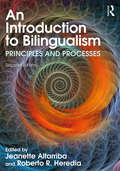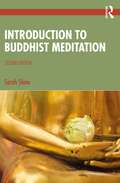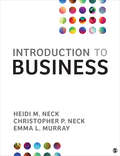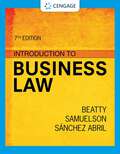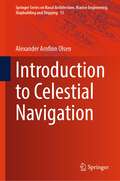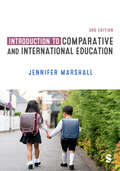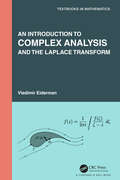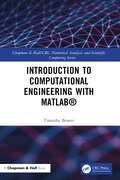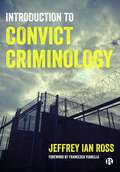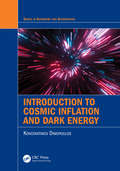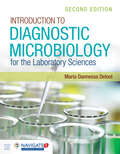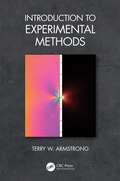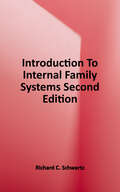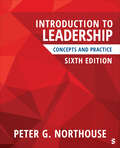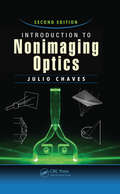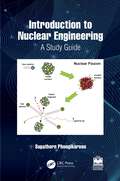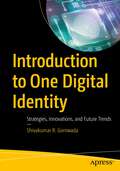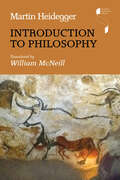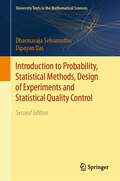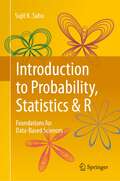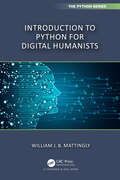- Table View
- List View
An Introduction to Bilingualism: Principles and Processes
by Jeanette Altarriba and Roberto R. HerediaThe study of bilingualism and all of its aspects – from theory and models to social approaches and their practical applications – forms the cornerstone of the 2nd edition of this work. The chapters cover the latest advancements in the domains of psycholinguistics, neuroscience, creativity, and executive functioning. Contributions, new to this edition, offer the reader the most up-to-date research on lifespan and developmental issues. The work also provides insight into how human language is processed by all, not just by bilingual and multilingual speakers.This text is ideal for senior undergraduate and graduate courses in psycholinguistics and the psychology of language, especially those with an emphasis on bilingualism or second language learning.
Introduction to Buddhist Meditation
by Sarah ShawThis lively introduction to Buddhist meditation offers students and practitioners alike a deeper understanding of what meditation is and its purpose and place in the context of different Buddhist schools. The historical background and geographical spread of Buddhist meditation is explored alongside an examination of the development of meditative practices. Chapters cover basic meditative practice, types of meditation, meditation in different regions, meditation and doctrine, and the role of chanting within meditation. Although not a practical guide, Introduction to Buddhist Meditation outlines the procedures associated with Buddhist practices and suggests appropriate activities, useful both for students and interested Buddhists. Vivid quotations from Buddhist texts and carefully selected photographs and diagrams help the reader engage fully with this fascinating subject.Thoroughly revised throughout, this new edition also features a glossary and key, making it ideal reading for students approaching the topic of Buddhist meditation for the first time.
Introduction to Business
by Heidi M. Neck Christopher P. Neck Emma L. MurrayIntroduction to Business ignites student engagement and prepares students for their professional journeys, regardless of their career aspirations. Best-selling authors Heidi M. Neck, Christopher P. Neck, and Emma L. Murray inspire students to see themselves in the world of business and to develop the mindset and skillset they need to succeed. A diverse set of impactful examples and cases, from inspiring startups and small businesses to powerful corporations, illustrate how businesses can prosper and create positive impact.
Introduction to Business
by Heidi M. Neck Christopher P. Neck Emma L. MurrayIntroduction to Business ignites student engagement and prepares students for their professional journeys, regardless of their career aspirations. Best-selling authors Heidi M. Neck, Christopher P. Neck, and Emma L. Murray inspire students to see themselves in the world of business and to develop the mindset and skillset they need to succeed. A diverse set of impactful examples and cases, from inspiring startups and small businesses to powerful corporations, illustrate how businesses can prosper and create positive impact.
Introduction to Business Law
by Jeffrey F. Beatty Susan S. Samuelson Patricia Sánchez AbrilDiscover the business law text you'll enjoy reading with Beatty/Samuelson/Abril's INTRODUCTION TO BUSINESS LAW, 7E. Students like you explain that this is the best text they have ever read and they had no idea law could be so interesting. This book uses conversational writing to explain complex topics and emerging legal trends in easy-to-understand language. With 75 years of combined teaching experience, these award-winning authors know how to clearly explain topics and keep your interest. Because the authors actually practiced law before they became teachers, they also describe how theories of law work in everyday business practice. This edition is packed with current examples and real-life scenarios relevant to daily life - from marijuana contracts and the research behind executive compensation to the impact of Covid-19 and #MeToo in the workplace. MindTap and Infuse digital resources help clarify concepts with interactive cases and learning tools.
Introduction to Celestial Navigation (Springer Series on Naval Architecture, Marine Engineering, Shipbuilding and Shipping #15)
by Alexander Arnfinn OlsenThis book focuses on Coastal and Ocean Navigation with an emphasis on celestial navigation techniques as a ‘back up’ in the event digital technologies fail.It deals with the main themes and principles of celestial navigation (including time). It covers the syllabus for deck officers working towards the Officer of the Watch (OOW) certificate of competence (COC) awarded by the Maritime and Coastguard Agency (MCA), and for Royal Navy navigation officers working towards achieving the equivalent Navigational Watch Certificate (NWC). The NWC is equivalent to the certificate awarded by the MCA to OOWs in the Merchant Service under the international Standardisation of Training, Certification and Watchkeeping (STCW) agreements. The detailed theory of celestial navigation is provided.
Introduction to Comparative and International Education
by Jennifer MarshallThis book introduces major themes surrounding comparative and international education, giving you a nuanced understanding of key debates, and thinkers, and the tools necessary to conduct comparisons using secondary sources. Social, economic, historical, and cultural factors are examined in order to investigate the varied contexts in which education takes place around the globe. This new edition includes: New case studies touching on contemporary issues from decolonising the curriculum to the impact of the Covid-19 pandemic on education A new introduction outlining the features of the book and how to use them Updated educational data from around the world and new links to external resources Dr Jennifer Marshall is Senior Lecturer in Education at the University of Derby.
Introduction to Comparative and International Education
by Jennifer MarshallThis book introduces major themes surrounding comparative and international education, giving you a nuanced understanding of key debates, and thinkers, and the tools necessary to conduct comparisons using secondary sources. Social, economic, historical, and cultural factors are examined in order to investigate the varied contexts in which education takes place around the globe. This new edition includes: New case studies touching on contemporary issues from decolonising the curriculum to the impact of the Covid-19 pandemic on education A new introduction outlining the features of the book and how to use them Updated educational data from around the world and new links to external resources Dr Jennifer Marshall is Senior Lecturer in Education at the University of Derby.
An Introduction to Complex Analysis and the Laplace Transform (Textbooks in Mathematics)
by Vladimir EidermanThe aim of this comparatively short textbook is a sufficiently full exposition of the fundamentals of the theory of functions of a complex variable to prepare the student for various applications. Several important applications in physics and engineering are considered in the book.This thorough presentation includes all theorems (with a few exceptions) presented with proofs. No previous exposure to complex numbers is assumed. The textbook can be used in one-semester or two-semester courses.In one respect this book is larger than usual, namely in the number of detailed solutions of typical problems. This, together with various problems, makes the book useful both for self- study and for the instructor as well.A specific point of the book is the inclusion of the Laplace transform. These two topics are closely related. Concepts in complex analysis are needed to formulate and prove basic theorems in Laplace transforms, such as the inverse Laplace transform formula. Methods of complex analysis provide solutions for problems involving Laplace transforms.Complex numbers lend clarity and completion to some areas of classical analysis. These numbers found important applications not only in the mathematical theory, but in the mathematical descriptions of processes in physics and engineering.
Introduction to Computational Engineering with MATLAB® (Chapman & Hall/CRC Numerical Analysis and Scientific Computing Series)
by Timothy BowerIntroduction to Computational Engineering with MATLAB® aims to teach readers how to use MATLAB programming to solve numerical engineering problems. The book focuses on computational engineering with the objective of helping engineering students improve their numerical problem-solving skills. The book cuts a middle path between undergraduate texts that simply focus on programming and advanced mathematical texts that skip over foundational concepts, feature cryptic mathematical expressions, and do not provide sufficient support for novices.Although this book covers some advanced topics, readers do not need prior computer programming experience or an advanced mathematical background. Instead, the focus is on learning how to leverage the computer and software environment to do the hard work. The problem areas discussed are related to data-driven engineering, statistics, linear algebra, and numerical methods. Some example problems discussed touch on robotics, control systems, and machine learning.Features: Demonstrates through algorithms and code segments how numeric problems are solved with only a few lines of MATLAB code Quickly teaches students the basics and gets them started programming interesting problems as soon as possible No prior computer programming experience or advanced math skills required Suitable for students at undergraduate level who have prior knowledge of college algebra, trigonometry, and are enrolled in Calculus I MATLAB script files, functions, and datasets used in examples are available for download from http://www.routledge.com/9781032221410.
Introduction to Convict Criminology
by Jeffrey Ian RossConvict criminology (CC) is based on the belief that the convict’s voice has been traditionally ignored or marginalized in scholarship and policy debates, and that its inclusion can positively impact the fields of corrections, criminology, criminal justice, and policy making. Designed for students, scholars, and activists worldwide this is the first sole-authored book to comprehensively explain the CC approach to scholarship, teaching, mentorship, and prison and criminal justice activism. It reviews the history and scholarship on this engaging field and the challenges that the approach has encountered. It features: • exhibit boxes • keywords • test questions - including multiple choice, short answer and essay format.
Introduction to Cosmic Inflation and Dark Energy (ISSN)
by Konstantinos DimopoulosCosmic inflation and dark energy hold the key to the origin and the eventual fate of the Universe. Despite the increasing prominence of these subjects in research and teaching over the past decade or more, no introductory textbook dedicated to these topics has been previously published. Dr. Konstantinos Dimopoulos is a highly regarded expert in the field, and an experienced communicator of the subject to students. In this book, he provides advanced undergraduate and early graduate students with an accessible introduction and equips them with the tools they need to understand the cosmology of cosmic inflation and dark energy.Features: Provides a concise, pedagogical "crash course" in big bang cosmology, focusing on the dynamics and the history of the Universe, with an emphasis on the role of dark energy Chapters contain questions and problems for readers to test their understanding The first book to make cosmic inflation and dark energy accessible to students
Introduction to Diagnostic Microbiology for the Laboratory Sciences
by Maria Dannessa DelostIntroduction to Diagnostic Microbiology for the Laboratory Sciences, Second Edition provides a concise study of clinically significant microorganisms for the medical laboratory student and laboratory practitioner.
Introduction To Environmental Engineering
by C. David CooperDr. Cooper’s 35 years of university experience and his award-winning teaching style are evident in this highly readable, authoritative introduction to environmental engineering. Appropriate for all branches of engineering, this text presents fundamental knowledge in a logical, up-to-date manner, incorporating abundant examples with step-by-step solutions to illustrate key concepts. Central to Cooper’s treatment is the use of material and energy balances to solve specific environmental engineering problems and to instill a problem-solving mind-set that will benefit readers throughout their careers. Introduction to Environmental Engineering offers an overview of the profession and reviews the math and science essential to environmental engineering practice. The comprehensive coverage includes water resources, drinking water treatment, wastewater treatment, air pollution control, solid and hazardous wastes, energy resources, risk assessment, indoor air quality, and noise pollution. Featuring more than 80 graphics, real-world examples, and extensive end-of-chapter problems (with selected answers), this volume is an outstanding choice for a first course in environmental engineering.
Introduction to Experimental Methods
by Terry W. ArmstrongIntroduction to Experimental Methods succinctly explains fundamental engineering concepts in mechanics, dynamics, heat transfer, and fluid dynamics. From conceptualizing an engineering experiment to conducting a comprehensive lab, this book enables students to work through the entire experimental design process.Offering a complete overview of instruction for engineering lab methodology, the book includes practical lab manuals for student use, directly complementing the instruction. Numerous worked examples and problems are presented along with several hands-on experiments in individual lab manuals. This book discusses how to write lab reports, how to configure a variety of instruments and equipment, and how to work through failures in experimentation.Introduction to Experimental Methods is intended for senior undergraduate engineering students taking courses in Experimental Methods. Instructors will be able to utilize a Solutions Manual for their course.Features: Provides an overview of experimental methods in mechanics, dynamics, heat transfer, and fluid dynamics Covers design of experiments, instruments, and statistics Discusses SolidWorks and PASCO Capstone software Includes numerous end-of-chapter problems and worked problems Features a Solutions Manual for instructor use
Introduction To Internal Family Systems
by Richard C. SchwartzA highly accessible introduction to a therapeutic approach that brings our inner “parts” into harmony and allows our core Self to lead We’re all familiar with self-talk, self-doubt, and self-judgment―yet most of us still view ourselves as if we have one uniform mind. Dr. Richard Schwartz’s breakthrough was recognizing that we each contain an “internal family” of distinct parts―and that treating these parts with curiosity, respect, and empathy vastly expands our capacity to heal. Over the past two decades, Internal Family Systems (IFS) has transformed the practice of psychotherapy. With Introduction to Internal Family Systems, the creator of IFS presents the ideal layperson’s guide for understanding this empowering, effective, and non-pathologizing approach to self-discovery and healing. Here, Dr. Schwartz shares evidence, case studies, and self-care tools to help you: - Shift from the limiting “mono-mind” paradigm into an appreciation of your marvelous, multidimensional nature - Unburden your wounded parts from extreme beliefs, emotions, and addictions - Demystify the most commonly misunderstood parts―the Exiles, Managers, and Firefighters - Transform your most challenging parts from inner obstacles to invaluable allies - Embrace the existence of innate human goodness―in yourself and others - Connect with the true Self that is greater than the sum of your parts “The most wonderful discovery I have made is that as you do this work, you release, or liberate, what I call your Self or your True Self―the calm, compassionate essence of who you are,” says Dr. Schwartz. “When the Self becomes the leading intelligence in our lives, we create more harmony―both within ourselves and in our external lives.” For therapists, their clients, and anyone interested in understanding and healing themselves, here is an essential guide to a revolutionary approach to self-realization, mental wellness, and transformation.
Introduction to Leadership: Concepts and Practice
by Peter G. NorthouseNew chapter on Working with Groups! The Sixth Edition of Peter G. Northouse′s best-selling Introduction to Leadership: Concepts and Practice provides readers with a clear, concise overview of the complexities of practicing leadership and concrete strategies for becoming better leaders. The text is organized around key leader responsibilities such as creating a vision, engaging strengths, and managing conflict. Case studies, self-assessment questionnaires, observational exercises, and reflection and action worksheets allow readers to apply leadership concepts to their own lives. Grounded in leadership theory and the latest research, the fully updated, highly practical new edition includes a new chapter on working with groups, 2 new cases, and 6 new Leadership Snapshots. This title is accompanied by a complete teaching and learning package. Contact your Sage representative to request a demo. Learning Platform / Courseware Sage Vantage is an intuitive learning platform that integrates quality Sage textbook content with assignable multimedia activities and auto-graded assessments to drive student engagement and ensure accountability. Unparalleled in its ease of use and built for dynamic teaching and learning, Vantage offers customizable LMS integration and best-in-class support. It′s a learning platform you, and your students, will actually love. Learn more. Assignable Video with Assessment Assignable video (available in Sage Vantage) is tied to learning objectives and curated exclusively for this text to bring concepts to life. Watch a sample video now. LMS Cartridge: Import this title’s instructor resources into your school’s learning management system (LMS) and save time. Don’t use an LMS? You can still access all of the same online resources for this title via the password-protected Instructor Resource Site. Learn more.
Introduction to Leadership: Concepts and Practice
by Peter G. NorthouseNew chapter on Working with Groups! The Sixth Edition of Peter G. Northouse′s best-selling Introduction to Leadership: Concepts and Practice provides readers with a clear, concise overview of the complexities of practicing leadership and concrete strategies for becoming better leaders. The text is organized around key leader responsibilities such as creating a vision, engaging strengths, and managing conflict. Case studies, self-assessment questionnaires, observational exercises, and reflection and action worksheets allow readers to apply leadership concepts to their own lives. Grounded in leadership theory and the latest research, the fully updated, highly practical new edition includes a new chapter on working with groups, 2 new cases, and 6 new Leadership Snapshots. This title is accompanied by a complete teaching and learning package. Contact your Sage representative to request a demo. Learning Platform / Courseware Sage Vantage is an intuitive learning platform that integrates quality Sage textbook content with assignable multimedia activities and auto-graded assessments to drive student engagement and ensure accountability. Unparalleled in its ease of use and built for dynamic teaching and learning, Vantage offers customizable LMS integration and best-in-class support. It′s a learning platform you, and your students, will actually love. Learn more. Assignable Video with Assessment Assignable video (available in Sage Vantage) is tied to learning objectives and curated exclusively for this text to bring concepts to life. Watch a sample video now. LMS Cartridge: Import this title’s instructor resources into your school’s learning management system (LMS) and save time. Don’t use an LMS? You can still access all of the same online resources for this title via the password-protected Instructor Resource Site. Learn more.
Introduction to Nonimaging Optics
by Julio ChavesIntroduction to Nonimaging Optics covers the theoretical foundations and design methods of nonimaging optics, as well as key concepts from related fields. This fully updated, revised, and expanded Second Edition: Features a new and intuitive introduction with a basic description of the advantages of nonimaging optics Adds new chapters on wavefronts for a prescribed output (irradiance or intensity), infinitesimal étendue optics (generalization of the aplanatic optics), and Köhler optics and color mixing Incorporates new material on the simultaneous multiple surface (SMS) design method in 3-D, integral invariants, and étendue 2-D Contains 21 chapters, 24 fully worked and several other examples, and 1,000+ illustrations, including photos of real devices Addresses applications ranging from solar energy concentration to illumination engineering Introduction to Nonimaging Optics, Second Edition invites newcomers to explore the growing field of nonimaging optics, while providing seasoned veterans with an extensive reference book.
Introduction to Nuclear Engineering: A Study Guide
by Supathorn PhongikaroonIntroduction to Nuclear Engineering serves as an accompanying study guide for a complete, introductory single-semester course in nuclear engineering. It is structured for general class use, alongside fundamental nuclear physics and engineering textbooks, and it is equally suited for individual self-study.The book begins with basic modern physics with atomic and nuclear models. It goes on to cover nuclear energetics, radioactivity and decays, and binary nuclear reactions and basic fusion. Exploring basic radiation interactions with matter, the book finishes by discussing nuclear reactor physics, nuclear fuel cycles, and radiation doses and hazard assessment. Each chapter highlights basic concepts, examples, problems with answers, and a final assessment.The book is intended for first-year undergraduate and graduate engineering students taking Nuclear Engineering and Nuclear Energy courses.
Introduction to One Digital Identity: Strategies, Innovations, and Future Trends
by Shivakumar R. GoniwadaExplore the dynamics of digital identity, a crucial component in today’s modern technology-driven era. This engaging book offers a deep understanding of how digital identity is evolving rapidly, why it’s so significant, and offers organizations, regulatory bodies, and academicians the strategies needed to adopt secure decentralized digital identity features effectively. It’s a must-read for those aiming to grasp the intricacies of digital identity and leverage it for future innovation and security.The book begins by redefining digital identity, examining its evolution and the profound impact it has on both individuals and organizations. It then delves into the development of digital identity strategies, laying the foundation for future digital transformations. Covering a wide range of topics, the book discusses the innovation, challenges, and technological exploration in digital identity. A special focus is given to biometric technologies and the implementation of decentralized digital identities, addressing critical areas such as identity governance, blockchain, AI and advanced biometrics. The book also investigates the implications of digital identity across various industries, including cross border travel, healthcare, social media, finance, metaverse, IoT etc. finally the book provides not only emerging trends but offers a glimpse into the future digital identity. Whether you’re a tech professional, business leader, student or simply keen on understanding the impact of digital advancements, this book promises to offer insightful perspectives and practical solutions for navigating the complex world of digital identity. It underscores the importance of identity in spearheading digital innovation, making it a key resource for anyone looking to stay ahead in the digital landscape. As you reach its conclusion, you’ll be equipped with a wealth of knowledge and insights that are crucial in today’s digital era.What You'll LearnDigital identity strategies and their role in shaping the future of digital identityDifferent facets of digital identitySpecifics of biometric technologies and decentralized digital identity Industry specific digital identity and its implementationCrucial aspects of privacy, ethics, and secure in the context of digital identityWho This Book Is ForSoftware professionals, security practitioners, architects, senior managers, executives, and students who are interested in digital identity.
Introduction to Philosophy (Studies in Continental Thought)
by Martin HeideggerIntroduction to Philosophy (volume 27 of Heidegger's Complete Works) presents Heidegger's lecture course delivered in the winter semester of 1928–1929 at the University of Freiburg, translated into English for the first time by William McNeil. In this lecture series, Heidegger explores two major themes: the relation between philosophy and science and the relation between philosophy and Weltanschauung (worldview). Through extensive analyses of truth, unconcealment, and transcendence, he delves into topics that would expand into his later work. From being-with and community to the phenomenon of world and the "play" of world, Heidegger covers a wide range of philosophical concepts with unprecedented clarity and profound insight. Introduction to Philosophy offer an encounter with a true master at work.
Introduction to Probability, Statistical Methods, Design of Experiments and Statistical Quality Control (University Texts in the Mathematical Sciences)
by Dharmaraja Selvamuthu Dipayan DasThis revised book provides an accessible presentation of concepts from probability theory, statistical methods, the design of experiments, and statistical quality control. It is shaped by the experience of the two teachers teaching statistical methods and concepts to engineering students. Practical examples and end-of-chapter exercises are the highlights of the text, as they are purposely selected from different fields. Statistical principles discussed in the book have a great relevance in several disciplines like economics, commerce, engineering, medicine, health care, agriculture, biochemistry, and textiles to mention a few.Organised into 16 chapters, the revised book discusses four major topics—probability theory, statistical methods, the design of experiments, and statistical quality control. A large number of students with varied disciplinary backgrounds need a course in basics of statistics, the design of experiments and statistical quality control at an introductory level to pursue their discipline of interest. No previous knowledge of probability or statistics is assumed, but an understanding of calculus is a prerequisite. The whole book also serves as a master level introductory course in all the three topics, as required in textile engineering or industrial engineering.
Introduction to Probability, Statistics & R: Foundations for Data-Based Sciences
by Sujit K. SahuA strong grasp of elementary statistics and probability, along with basic skills in using R, is essential for various scientific disciplines reliant on data analysis. This book serves as a gateway to learning statistical methods from scratch, assuming a solid background in high school mathematics. Readers gradually progress from basic concepts to advanced statistical modelling, with examples from actuarial, biological, ecological, engineering, environmental, medicine, and social sciences highlighting the real-world relevance of the subject. An accompanying R package enables seamless practice and immediate application, making it ideal for beginners. The book comprises 19 chapters divided into five parts. Part I introduces basic statistics and the R software package, teaching readers to calculate simple statistics and create basic data graphs. Part II delves into probability concepts, including rules and conditional probability, and introduces widelyused discrete and continuous probability distributions (e.g., binomial, Poisson, normal, log-normal). It concludes with the central limit theorem and joint distributions for multiple random variables. Part III explores statistical inference, covering point and interval estimation, hypothesis testing, and Bayesian inference. This part is intentionally less technical, making it accessible to readers without an extensive mathematical background. Part IV addresses advanced probability and statistical distribution theory, assuming some familiarity with (or concurrent study of) mathematical methods like advanced calculus and linear algebra. Finally, Part V focuses on advanced statistical modelling using simple and multiple regression and analysis of variance, laying the foundation for further studies in machine learning and data science applicable to various data and decision analytics contexts. Based on years of teaching experience, this textbook includes numerousexercises and makes extensive use of R, making it ideal for year-long data science modules and courses. In addition to university courses, the book amply covers the syllabus for the Actuarial Statistics 1 examination of the Institute and Faculty of Actuaries in London. It also provides a solid foundation for postgraduate studies in statistics and probability, or a reliable reference for statistics.
Introduction to Python for Humanists (Chapman & Hall/CRC The Python Series)
by William MattinglyThis book will introduce digital humanists at all levels of education to Python. It provides background and guidance on learning the Python computer programming language, and as it presumes no knowledge on the part of the reader about computers or coding concepts allows the reader to gradually learn the more complex tasks that are currently popular in the field of digital humanities. This book will be aimed at undergraduates, graduates, and faculty who are interested in learning how to use Python as a tool within their workflow. An Introduction to Python for Digital Humanists will act as a primer for students who wish to use Python, allowing them to engage with more advanced textbooks. This book fills a real need, as it is first Python introduction to be aimed squarely at humanities students, as other books currently available do not approach Python from a humanities perspective. It will be designed so that those experienced in Python can teach from it, in addition to allowing those who are interested in being self-taught can use it for that purpose.Key Features: Data analysis Data science Computational humanities Digital humanities Python Natural language processing Social network analysis App development
